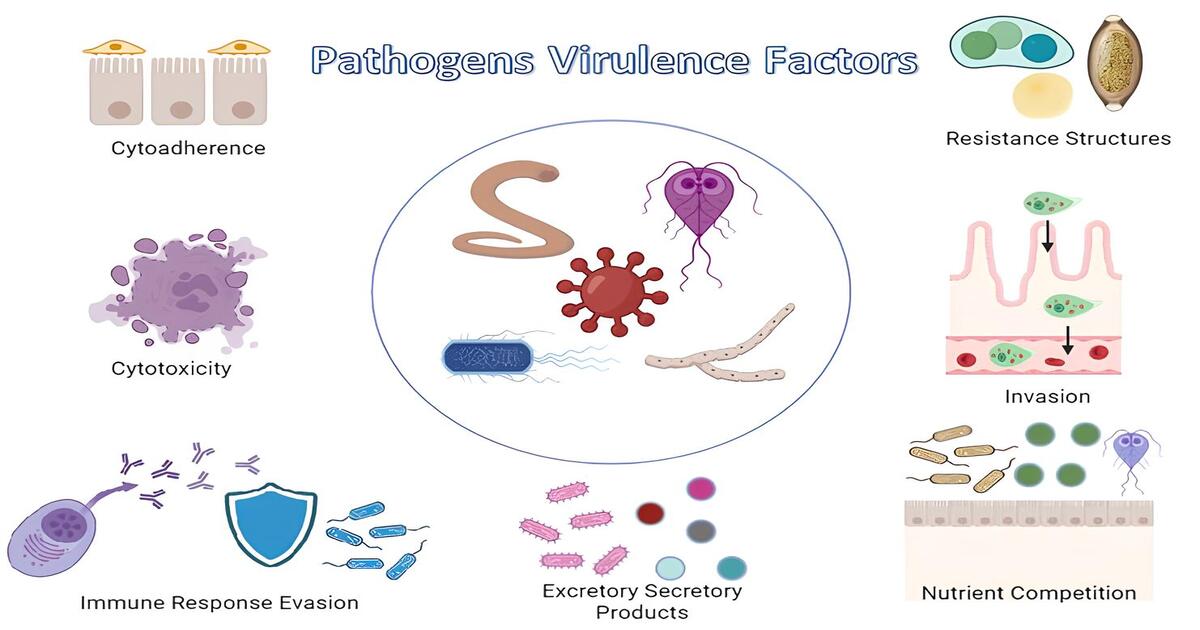Virulence Mechanisms Used by Pathogens Related to Human, Animal, and Environmental Health
A special issue of Pathogens (ISSN 2076-0817).
Deadline for manuscript submissions: 15 July 2026 | Viewed by 8075

Special Issue Editors
Interests: iron regulation; virulence; protozoan
2. Department of Research, Pediatric Hospital of Sinaloa, Secretary of Health, Culiacan 80246, Mexico
Interests: proteins and peptides with antimicrobial and antitumor properties; cell biology; microbiology; infectious diseases; vaccines
Special Issues, Collections and Topics in MDPI journals
2. The Women's Hospital, Secretariat of Health, 80020 Culiacan Sinaloa, Mexico
Interests: public health; enteropathogens; virulence genes; epidemiology; food-borne pathogens
Special Issues, Collections and Topics in MDPI journals
Special Issue Information
Dear Colleagues,
Pathogenic microorganisms are involved in human mortality and morbidity, causing a significant health and economic burden worldwide. In addition, pathogens are implicated in animal health and environmental damage, affecting global food production and marketing, further complicating the global picture. Few drug treatments have been effective due to increasing drug resistance and the mechanisms many pathogens have evolved to evade the immune system. On the other hand, microbes that affect plants are a major problem worldwide, as pathogens are becoming resistant to various pesticides and increasingly difficult to control. In addition, more and more pathogens contaminate river water used for recreation, irrigation of crops, or domestic consumption. We need to understand how pathogens interfere with this to promote the health of people, animals, and the planet.
Mechanisms of pathogenicity include various virulence factors that microbes use to survive in the environment and cause damage. Multiple mechanisms and environmental factors often regulate these virulence factors to ensure successful infection. In this Special Issue, we review several pathogenic microbes of global importance, focusing on the virulence mechanisms used to cause damage to human, animal, and environmental health.
In this Special Issue, original research articles and reviews are welcome. Research areas may include the mechanisms of pathogenicity of microbes affecting human, animal, and environmental health.
We look forward to receiving your contributions.
Prof. Dr. Claudia León-Sicairos
Prof. Dr. Nidia M. León-Sicairos
Prof. Dr. Adrian Canizalez-Roman
Guest Editors
Manuscript Submission Information
Manuscripts should be submitted online at www.mdpi.com by registering and logging in to this website. Once you are registered, click here to go to the submission form. Manuscripts can be submitted until the deadline. All submissions that pass pre-check are peer-reviewed. Accepted papers will be published continuously in the journal (as soon as accepted) and will be listed together on the special issue website. Research articles, review articles as well as short communications are invited. For planned papers, a title and short abstract (about 250 words) can be sent to the Editorial Office for assessment.
Submitted manuscripts should not have been published previously, nor be under consideration for publication elsewhere (except conference proceedings papers). All manuscripts are thoroughly refereed through a single-blind peer-review process. A guide for authors and other relevant information for submission of manuscripts is available on the Instructions for Authors page. Pathogens is an international peer-reviewed open access monthly journal published by MDPI.
Please visit the Instructions for Authors page before submitting a manuscript. The Article Processing Charge (APC) for publication in this open access journal is 2200 CHF (Swiss Francs). Submitted papers should be well formatted and use good English. Authors may use MDPI's English editing service prior to publication or during author revisions.
Keywords
- virulence mechanisms
- pathogens
- global health
- pathogenicity
- virulence factors
Benefits of Publishing in a Special Issue
- Ease of navigation: Grouping papers by topic helps scholars navigate broad scope journals more efficiently.
- Greater discoverability: Special Issues support the reach and impact of scientific research. Articles in Special Issues are more discoverable and cited more frequently.
- Expansion of research network: Special Issues facilitate connections among authors, fostering scientific collaborations.
- External promotion: Articles in Special Issues are often promoted through the journal's social media, increasing their visibility.
- Reprint: MDPI Books provides the opportunity to republish successful Special Issues in book format, both online and in print.
Further information on MDPI's Special Issue policies can be found here.








